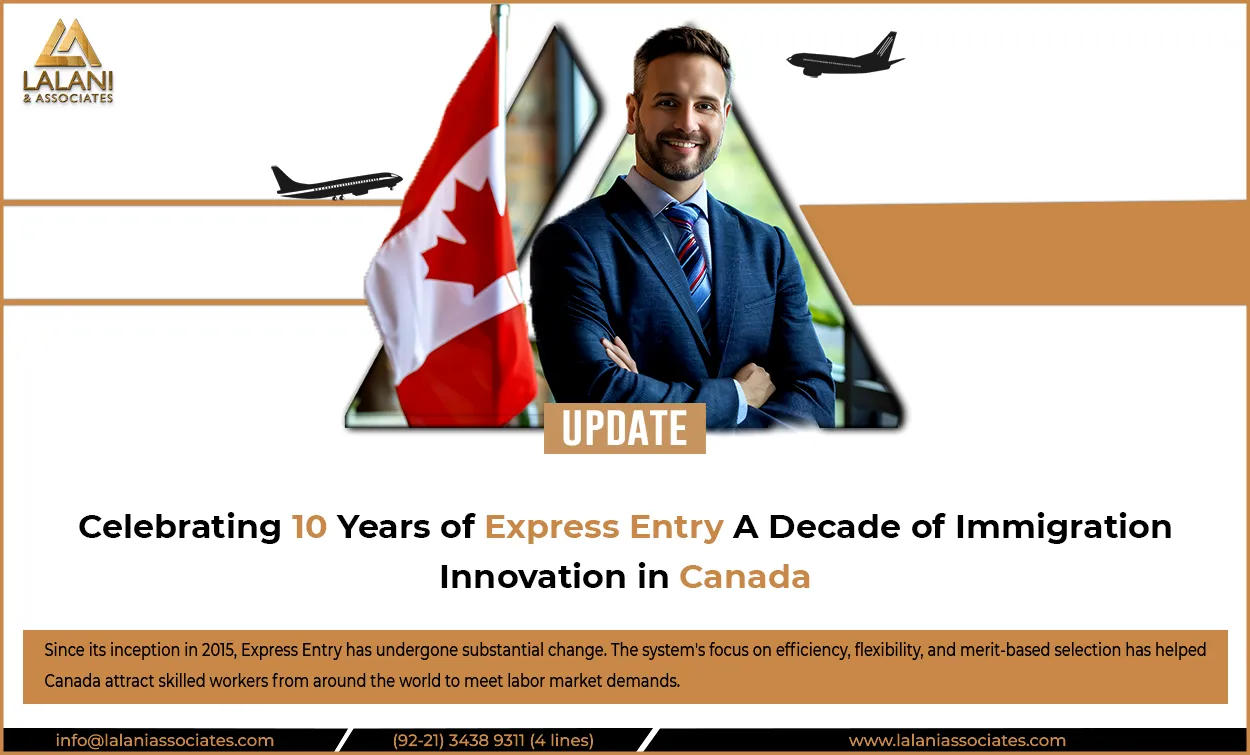
Canada's Express Entry System: Celebrating 10 Years of Immigration Innovation
January 31, 2025, marks the tenth anniversary of Canada's groundbreaking Express Entry system, which has transformed the country's immigration landscape since its launch in 2015. Under this innovative, pool-based system, Immigration, Refugees, and Citizenship Canada (IRCC) have issued more than 800,000 Invitations to Apply (ITAs) for Permanent Residency (PR) to foreign nationals over the past decade.
Express Entry has fundamentally altered Canada's immigration application process, making it more responsive to labor market demands and commercial interests. Because it has made the path to permanent residence faster, more accessible, and more effective, professionals from all over the world can now contribute to Canada's economy. This article examines the evolution of Express Entry, its key characteristics, and its continued impact on immigration policy in Canada.
➤ Why Was Express Entry Created?
Before Express Entry, Canada used a first-come, first-served system for skilled worker applications. In the old system, eligible foreign people could apply for permanent residence (PR) and would be considered permanent residents after their petitions were processed. However, this strategy led to lengthy processing times and massive backlogs. In the past, it may take up to seven years to process a PR application. Applicants frequently found that they were waiting so long that they were no longer qualified for the employment they first qualified for due to changes in their personal or professional circumstances.
To address these challenges, the Canadian government launched the Express Entry program in January 2015. Express Entry sought to reform Canada's immigration system by using a more straightforward, merit-based selection procedure. This made it possible for the Canadian government to manage the backlog, adapt to shifting labor market demands, and ensure that applications are processed promptly.
➤ How Express Entry Changed Canada's Immigration System
Express Entry substantially cut processing times and raised the system's efficiency by introducing a pool-based approach for handling applications for Permanent Residency (PR) from trained personnel. Those hoping to get PR first build an Expression of Interest (EOI) profile within the Express Entry pool. The Comprehensive Ranking System (CRS) gives points based on elements, including their profiles' ranking.
• Age
• Education
• Language proficiency
• Work experience
The highest CRS candidates are asked to apply for PR via IRCC's regular drawings. This approach helps to guarantee short processing times and prioritizes the most qualified candidates. Actually, successful applicants under Express Entry should normally expect their applications to be handled in six months, which is a notable change from the previous method.
This system's primary benefit is that it lets provinces and companies choose individuals from the Express Entry pool who would be most fit to cover labor market shortages. Applications for four primary economic immigration programs are handled by the initiative:
• Federal Skilled Worker Program (FSWP)
• Federal Skilled Trades Program (FSTP)
• Canadian Experience Class (CEC)
• Provincial Nominee Program (PNP)
By use of these initiatives, qualified professionals from all around the world can apply for PR, their eligibility decided by objective criteria including work experience and education.
➤ Key Changes in Express Entry Over the Last 10 Years
Express Entry has changed significantly since its launch in 2015 in response to changes in Canada's immigration policies, labor market, and economic demands. These changes have increased the system's flexibility and inclusiveness. Some of the most important modifications are below:
ⅰ. Job Offers and CRS Points
Early on in Express Entry, candidates with genuine employment offers in Canada received 600 extra CRS points, which frequently helped to produce high CRS cut-off values in the early drawings. But in 2016, the government instituted "target" improvements "to the" system that cut the points given for employment offers.
Under the changed method, candidates with job offers in some National Occupational Classification (NOC) categories gained 50 or 200 extra points based on the NOC code of the position. This modification sought to balance and fairly operate the system. The Canadian government declared that all job offer points would be removed from the CRS by December 2024; the expected effect would be seen in the Spring of 2025.
ⅱ. Educational Credentials
The CRS also began awarding points based on a candidate’s education. Starting in 2016, candidates were awarded additional CRS points for holding diplomas, degrees, or certificates from recognized institutions.
Candidates could earn:
• 15 points for a one- to two-year diploma or certificate.
• 30 points for a degree, diploma, or certificate of three years or longer.
This change reflected Canada’s increasing focus on attracting highly educated immigrants to meet the country’s growing skilled labor.
ⅲ. Tie-breaking Rule
In 2017, IRCC implemented a tie-breaking rule to address scenarios where more candidates met the CRS cut-off score than there were invitations available. The rule used the submission date and time of candidate profiles to determine which applicants would be invited to apply. Candidates who submitted their profiles earlier would be given priority in the case of a tie, ensuring fairness in the selection process.
ⅳ. French Language Proficiency
The addition of extra points for applicants who showed fluency in French was another noteworthy modification in 2017. If a French speaker performs well on all four French language skills—speaking, listening, reading, and writing - they receive extra CRS points. Candidates can earn up to 30 extra CRS points if they score 7 or higher on these skills and have a strong grasp of English (CLB 5 or higher).
The purpose of this reform was to help recruit French-speaking immigrants to fill Canada's labor shortage, especially in non-Quebec provinces where there is a considerable demand for French speakers.
ⅴ. Siblings in Canada
Additional CRS points were added by the IRCC in 2017 for applicants who, or their accompanying spouse, had a sibling who was a Canadian citizen or permanent resident. The goal of this action was to improve family ties and facilitate immigrants' easier assimilation into Canadian society.
ⅵ. Category-based Selection
The IRCC implemented category-based selection in 2023, which enables draws to concentrate on particular economic sectors like commerce, transportation, healthcare, STEM (science, technology, engineering, and math) vocations, and agriculture. The purpose of this modification was to draw applicants with experience in in-demand disciplines and to address labor shortages in particular industries. Because the CRS cut-off scores for these focused draws were lower than those for general draws, it was simpler for people with specialized abilities to be eligible for PR.
➤ Impact of the COVID-19 Pandemic on Express Entry
Express Entry and other forms of immigration to Canada were significantly impacted by the COVID-19 outbreak. While draws for candidates in the Canadian Experience Class and Provincial Nominee Program continued, the IRCC halted general draws for approximately 18 months during the early phases of the epidemic. CRS scores varied as a result of this suspension; some drawings, like the February 2021 CEC draw, which invited 27,332 candidates with a cut-off CRS score of only 75, had exceptionally low cut-off scores.
In July 2022, IRCC restarted general drawings and made adjustments to meet the growing demand for skilled workers as the pandemic subsided and Canada adapted to new travel restrictions.
➤ Recent Developments and Future Outlook
In May 2024, the IRCC began holding more targeted draws for certain areas, like healthcare and French-language proficiency, with an emphasis on in-Canada candidates. This shift is anticipated to continue as the Canadian government seeks to reduce the number of non-permanent residents in the nation.
The Immigration Levels Plan 2025-2027 pledged to place greater emphasis on in-Canada applications with the goal of giving precedence to those who are already residing in Canada. This action aligns with the administration's goal of converting temporary residents into permanent residents.
Additionally, the federal government is increasing the amount of Express Entry allotments, as evidenced by the 2025–2027 levels plan. The continued importance of Express Entry in Canada's immigration policy is highlighted by the fact that it accounts for a greater portion of the overall economic immigration budget.
Conclusion
Since its inception in 2015, Express Entry has undergone substantial change. The system's focus on efficiency, flexibility, and merit-based selection has helped Canada attract skilled workers from around the world to meet labor market demands. As the immigration landscape evolves, Express Entry will continue to be a key tool in ensuring that Canada can sustain a high level of economic growth and prosperity. Because of ongoing enhancements and a focus on specific industries and applications, Express Entry is well-positioned to play a significant role in deciding Canada's immigration future for years to come.


0 Comments